2003 PONTIAC BONNEVILLE rear view mirror
[x] Cancel search: rear view mirrorPage 67 of 418
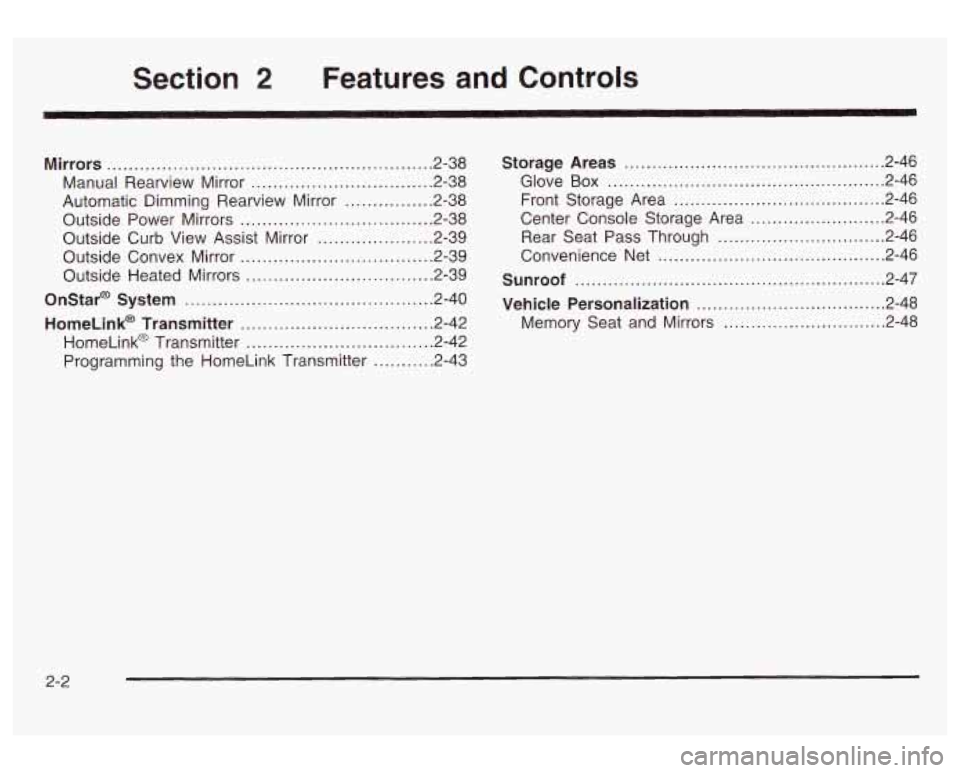
Section 2 Features and Controls
Mirrors .................................................... 2.38
Manual Rearview Mirror
................................. 2.38
Automatic Dimming Rearview Mirror
................ 2.38
Outside Power Mirrors
................................... 2.38
Outside Convex Mirror
................................... 2-39
Outside Heated Mirrors
.................................. 2-39
Onstar@ System ............................................. 2-40
HomeLink@ Transmitter ................................... 2-42
HomeLink@ Transmitter
................................. -2-42
Programming the HomeLink Transmitter
.......... -2-43
Outside
Curb View Assist Mirror
..................... 2-39
Storage Areas ................................................ 2.46
Glove
Box ................................................... 2.46
Front Storage Area
....................................... 2.46
Center Console Storage Area
.. ........... 2.46
Rear Seat Pass Through
........................... 2.46
Convenience Net
.......................................... 2.46
Sunroof ......................................................... 2.47
Vehicle Personalization ................................... 2.48
Memory Seat and Mirrors
.......................... 2.48
2-2
Page 103 of 418
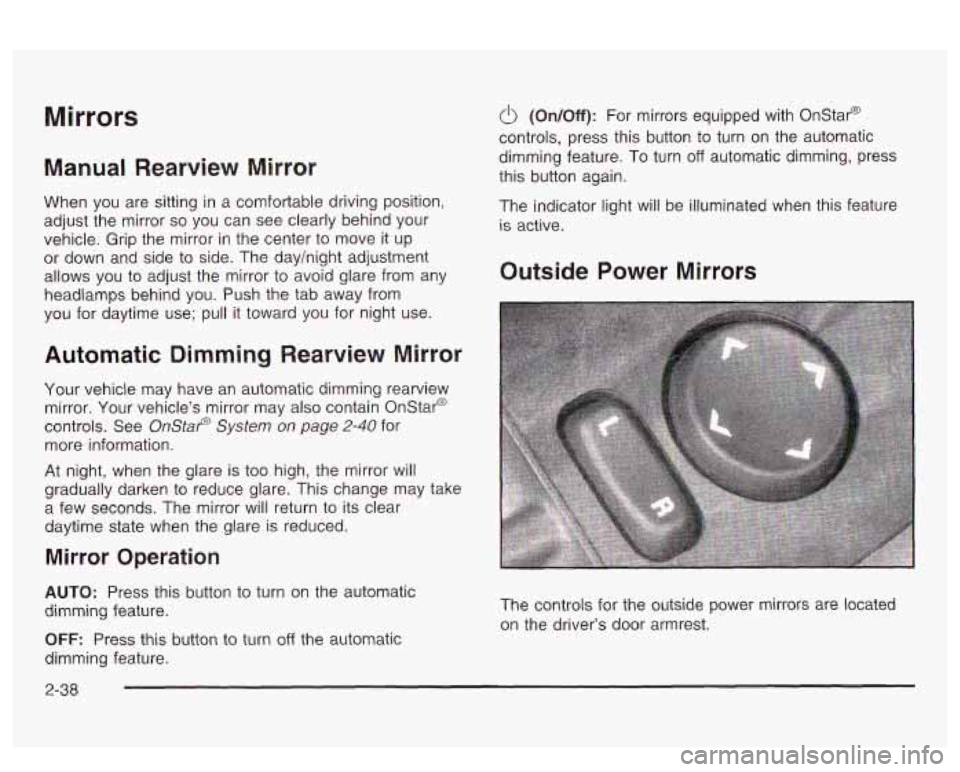
Mirrors
Manual Rearview Mirror
When you are sitting in a comfortable driving position,
adjust the mirror
so you can see clearly behind your
vehicle. Grip the mirror in the center to move it up
or down and side to side. The dayhight adjustment
allows you
to adjust the mirror to avoid glare from any
headlamps behind you. Push the tab away from
you for daytime use; pull it toward you for night use.
Automatic Dimming Rearview Mirror
Your vehicle may have an automatic dimming rearview
mirror. Your vehicle’s mirror may also contain Onstar@
controls. See
OnStaP System on page 2-40 for
more information.
At night, when the glare is too high, the mirror will
gradually darken to reduce glare. This change may take
a few seconds. The mirror will return to its clear
daytime state when the glare is reduced.
Mirror Operation
AUTO: Press this button to turn on the automatic
dimming feature.
OFF: Press this button to turn off the automatic
dimming feature.
6 (On/Off): For mirrors equipped with OnStaP
controls, press this button to turn on the automatic
dimming feature. To turn
off automatic dimming, press
this button again.
The indicator light will be illuminated when this feature
is active.
Outside Power Mirrors
The controls for the outside power mirrors are located
on the driver’s door armrest.
2-38
Page 104 of 418
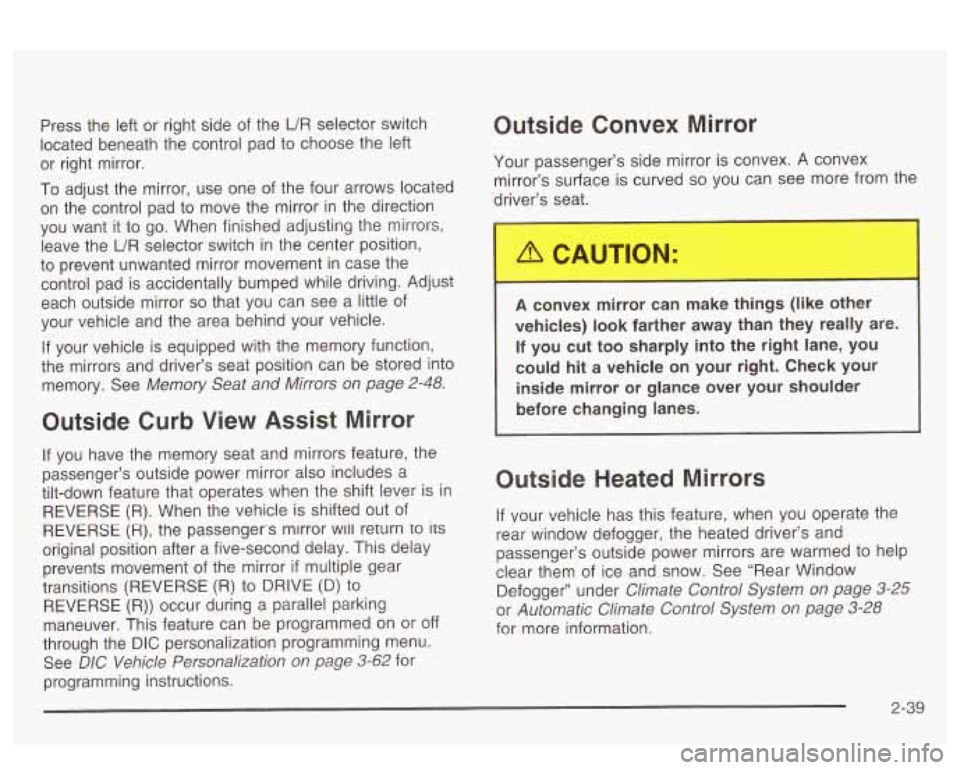
Press the left or right side of the UR selector switch
located beneath the control pad to choose the left
or right mirror.
To adjust the mirror, use one of the four arrows located
on the control pad to move the mirror in the direction
you want it to go. When finished adjusting the mirrors,
leave the UR selector switch in the center position,
to prevent unwanted mirror movement in case the
control pad is accidentally bumped while driving. Adjust
each outside mirror
so that you can see a little of
your vehicle and the area behind your vehicle.
If your vehicle is equipped with the memory function,
the mirrors and driver’s seat position can be stored into
memory. See
Memory Seat and Mirrors on page 2-48.
Qutside Curb View Assist Mirror
If you have the memory seat and mirrors feature, the
passenger’s outside power mirror also includes a
tilt-down feature that operates when the shift lever is in
REVERSE (R). When the vehicle is shifted out of
REVERSE
(R), the passenger’s mirror wtii return to ils
original position after a five-second delay. This delay
prevents movement of the mirror
if multiple gear
transitions (REVERSE
(R) to DRIVE (D) to
REVERSE (R)) occur during a parallel parking
maneuver. This feature can be programmed on or
off
through the DIC personalization programming menu.
See
DIC Vehicle Personalization on page 3-62 for
programming instructions.
Outside Convex Mirror
Your passenger’s side mirror is convex. A convex
mirror’s surface is curved
so you can see more from the
ver’s seat.
A convex mirror can make things (like other
vehicles)
look farther away than they really are.
If you cut too sharply into the right lane, you
could hit a vehicle on your right. Check your
inside mirror or glance over your shoulder
before changing lanes.
Outside Heated Mirrors
If vour vehicle has this feature, when you operate the
rear window defogger, the heated driver’s and
passenger’s outside power mirrors are warmed to help
clear them of ice and snow. See “Rear Window
Defogger’’ under
Climate Control System on page 3-25
or Automatic Climate Control System on page 3-28
for more information.
2-39
Page 233 of 418
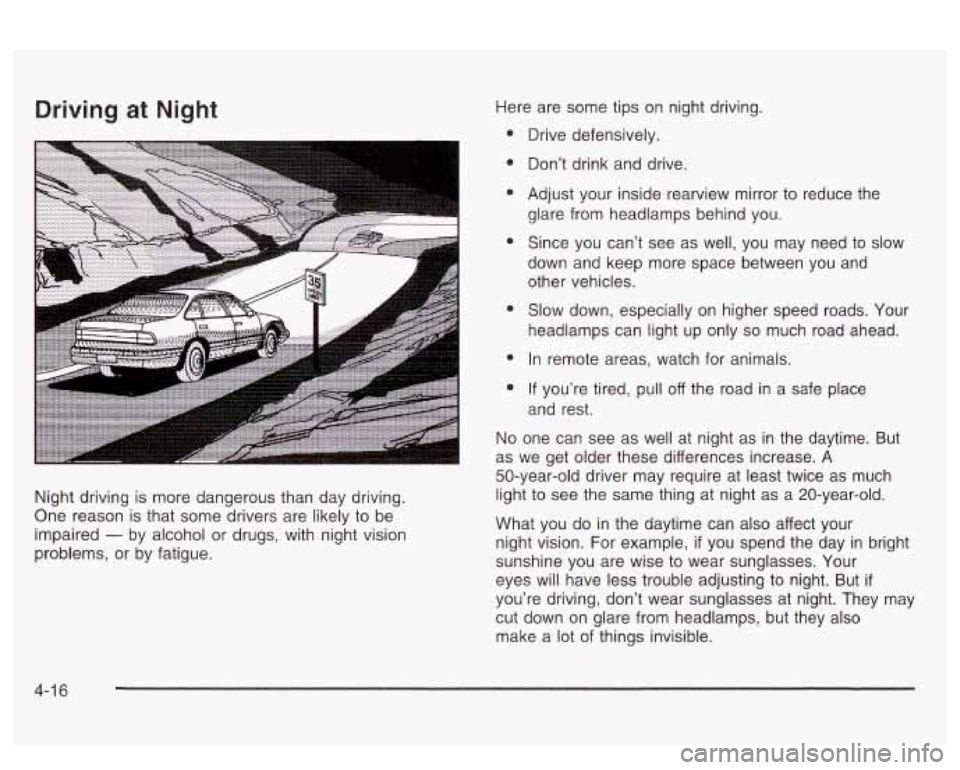
Driving at Night
Night driving is more dangerous than day driving.
One reason is that some drivers are likely to be
impaired
- by alcohol or drugs, with night vision
problems, or by fatigue. Here
are some tips on night driving.
Drive defensively.
Don’t drink and drive.
Adjust your inside rearview mirror to reduce the
glare from headlamps behind you.
Since you can’t see as well, you may need
to slow
down and keep more space between you and other vehicles.
Slow down, especially on higher speed roads. Your
headlamps can light up only
so much road ahead.
In remote areas, watch for animals.
If you’re tired, pull off the road in a safe place
and rest.
No one can see as well at night as in the daytime. But
as we get older these differences increase. A
50-year-old driver may require at least twice as much
light to see the same thing at night as a 20-year-old.
What you do in the daytime can also affect your
night vision.
For example, if you spend the day in bright
sunshine you are wise to wear sunglasses. Your
eyes will have less trouble adjusting to night. But
if
you’re driving, don’t wear sunglasses at night. They may
cut down on glare from headlamps, but they also
make a lot of things invisible.
4-1 6
Page 240 of 418
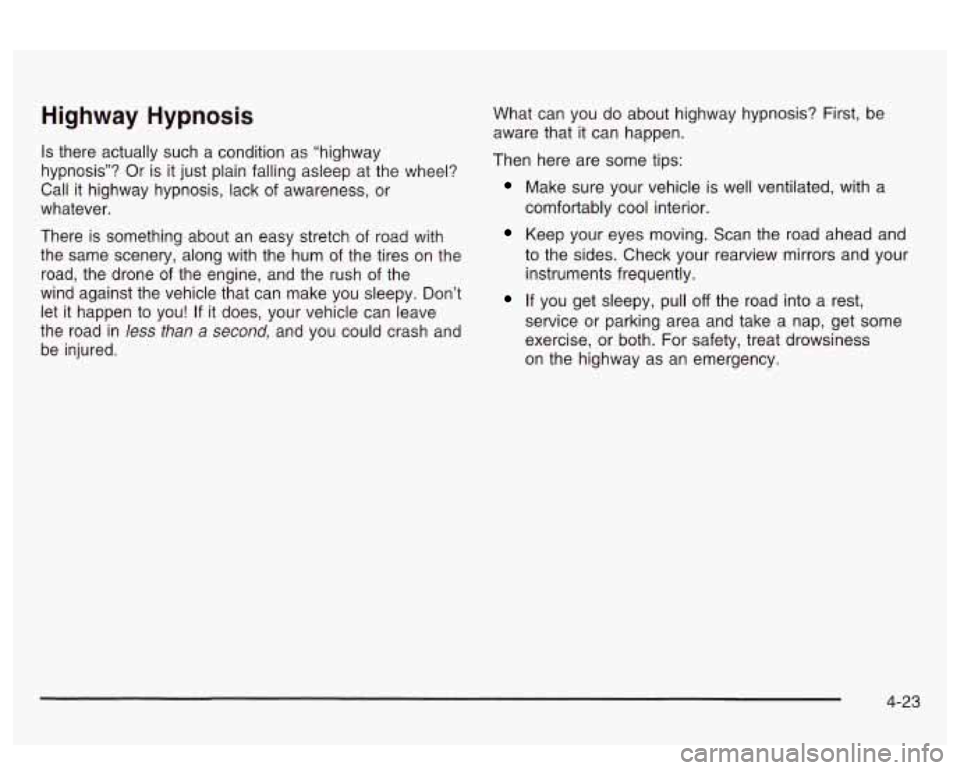
Highway Hypnosis
Is there actually such a condition as “highway
hypnosis”? Or is it just plain falling asleep at the wheel?
Call it highway hypnosis, lack of awareness, or
whatever.
There
is something about an easy stretch of road with
the same scenery, along with the hum of the tires on the
road, the drone
of the engine, and the rush of the
wind against the vehicle that can make you sleepy. Don’t
let it happen to you!
If it does, your vehicle can leave
the road in
less than a second, and you could crash and
be injured. What
can you do about highway hypnosis? First, be
aware that it can happen.
Then here are some tips:
Make sure your vehicle is well ventilated, with a
comfortably cool interior.
Keep your eyes moving. Scan the road ahead and
to the sides. Check your rearview mirrors and your
instruments frequently.
If you get sleepy, pull off the road into a rest,
service or parking area and take a nap, get some
exercise, or both. For safety, treat drowsiness
on the highway as an emergency.
4-23
Page 408 of 418
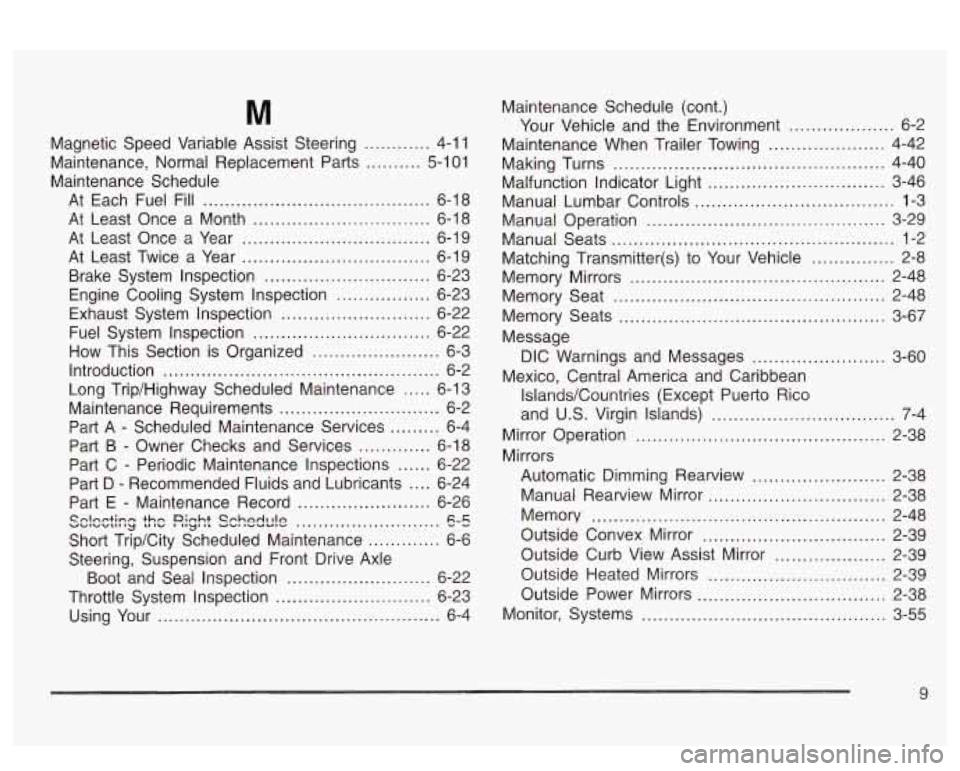
M
.... 4-11
... 5-101
Magnetic Speed Variable Assist
Steering
....
Maintenance. Normal Replacement Parts ....
Maintenance Schedule
At Each Fuel Fill
......................................... 6-18
At Least Once a Month
................................ 6-18
At Least Once a Year
.................................. 6-1 9
At Least Twice a Year
.................................. 6-19
Brake System Inspection
.............................. 6-23
Engine Cooling System Inspection
................. 6-23
Exhaust System Inspection
........................... 6-22
Fuel System Inspection
................................ 6-22
How This Section is Organized
....................... 6-3
Introduction
.................................................. 6-2
Long Trip/Highway Scheduled Maintenance
..... 6-1 3
Maintenance Requirements
............................. 6-2
Part
A - Scheduled Maintenance Services ......... 6-4
Part B
- Owner Checks and Services ............. 6-18
Part C
- Periodic Maintenance Inspections ...... 6-22
Part D
- Recommended Fluids and Lubricants .... 6-24
Part E
- Maintenance Record ........................ 6-26 Cnlnrrtinn thn Dinkt
CchndltIn .......................... 6-5 “-I””III my L . I” I ..y. IL -”I lWUUlW
Short Trip/City Scheduled Maintenance ............. 6-6
Boot and Seal Inspection
.......................... 6-22
Throttle System Inspection
............................ 6-23
Steering, Suspension
and Front Drive Axle
Using Your
................................................... 6-4 Maintenance
Schedule (cont.)
Your Vehicle and the Environment
................... 6-2
Maintenance When Trailer Towing
..................... 4-42
Making Turns
................................................. 4-40
Malfunction Indicator Light
................................ 3-46
Manual Lumbar Controls
.................................... 1-3
Manual Qperation
........................................... 3-29
Manual Seats
................................................... 1-2
Matching Transmitter(s) to Your Vehicle
............... 2-8
Memory Mirrors
.............................................. 2-48
Memory Seat
................................................. 2-48
Memory Seats
................................................ 3-67
Message DIC Warnings and Messages
........................ 3-60
Mexico, Central America and Caribbean
Islands/Csuntries (Except Puerto Rico
and U.S. Virgin Islands)
...................... .... 7-4
Mirror Operation
................................ ...... 2-38
Mirrors Automatic Dimming Rearview
........................ 2-38
Manual Rearview Mirror
................................ 2-38
Memory
..................................................... 2-48
Outside Convex Mirror
................................. 2-39
Outside Curb View Assist Mirror
.................... 2-39
Outside Heated Mirrors
................................ 2-39
Outside Power Mirrors
.................................. 2-38
Monitor, Systems
............................................ 3-55
9
Page 410 of 418
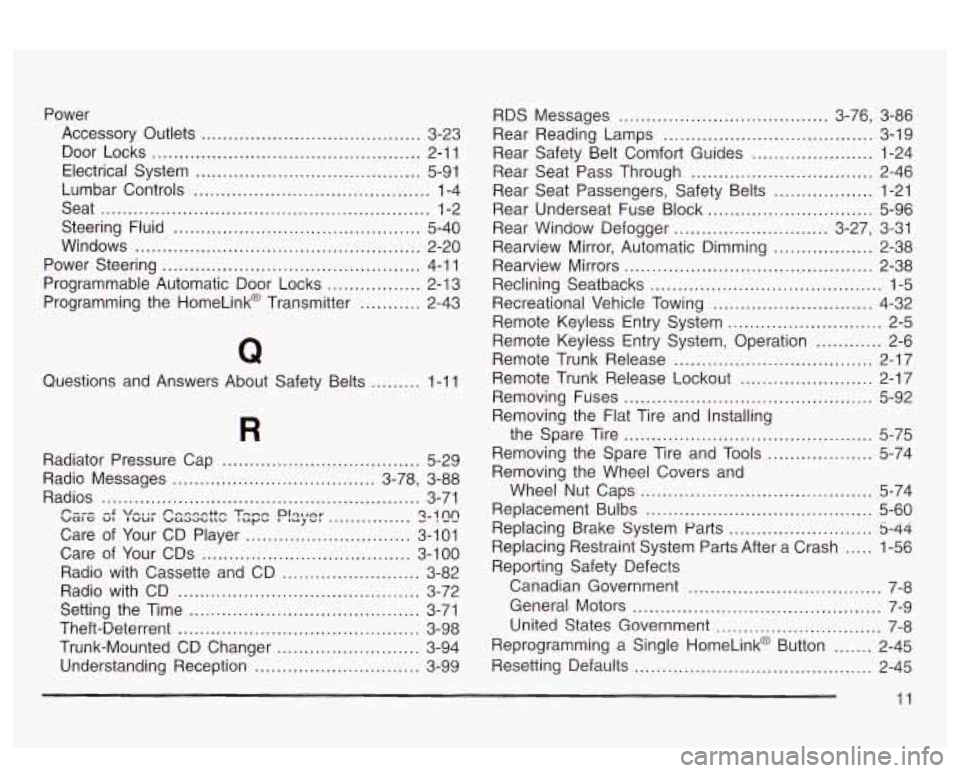
Power Accessory Outlets
........................................ 3-23
Door Locks
................................................. 2-1 1
Electrical System
......................................... 5-91
Lumbar Controls
........................................... 1-4
Seat
............................................................ 1-2
Steering Fluid
............................................. 5-40
Windows
.................................................... 2-20
Power Steering
............................................... 4-1 1
Programmable Automatic Door Locks
................. 2-1 3
Programming the HomeLink@ Transmitter
........... 2-43
Questions and Answers About Safety Belts
......... 1-1 1
Radiator Pressure Cap
.................................... 5-29
Radio Messages
..................................... 3.78. 3-88
Radios
.......................................................... 3-71
Care of Your CD Player
.............................. 3-101
Care of Your CDs
...................................... 3-100
Radio with Cassette and CD
......................... 3-82
Setting the Time
.......................................... 3-71
Theft-Deterrent
............................................ 3-98
Trunk-Mounted CD Changer .......................... 3-94
Understanding Reception
.............................. 3-99
-.E V-.,, P-nnnttn Tonn DlqBrnr ual~ VI I UUI WU.J.JCILL’CI mupu . .uJ-. ............... ?-:!x
Radio with CD ............................................ 3-72 RDS Messages
...................................... 3-76,
3-86
Rear Reading Lamps
...................................... 3-19
Rear Safety Belt Comfort Guides
...................... 1-24
Rear Seat Pass Through
................................. 2-46
Rear Underseat Fuse Block
.............................. 5-96
Rear Seat
Passengers, Safety Belts
.................. 1-21
Rear Window Defogger
............................ 3-27, 3-31
Rearview Mirror, Automatic Dimming
.................. 2-38
Rearview Mirrors
............................................. 2-38
Reclining Seatbacks
.......................................... 1-5
Recreational Vehicle Towing
............................. 4-32
Remote Trunk Release
.................................... 2-17
Remote Trunk Release Lockout
........................ 2-17
Removing Fuses
............................................. 5-92
the Spare Tire
............................. ..... 5-75
Removing the Spare Tire and Tools
... ..... 5-74
Wheel Nut Caps
.......................................... 5-74
Replacement Bulbs
......................................... 5-60
Remote
Keyless Entry System
............................ 2-5
Remote Keyless Entry System, Operation
............ 2-6
Removing the Flat Tire and Installing
Removing the Wheel Covers and
Replacing Brake System Parts
.......................... 5-44
Replacing Restraint System Parts After a Crash ..... 1-56
Reporting Safety Defects Canadian Government
................................... 7-8
General Motors
............................................. 7-9
United States Government .............................. 7-8
Reprogramming a Single HomeLink@ Button
....... 2-45
Resetting Defaults
........................................... 2-45
11